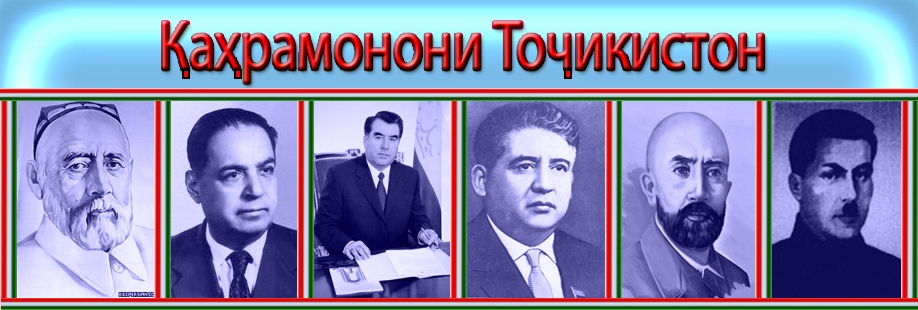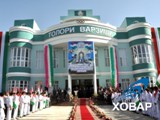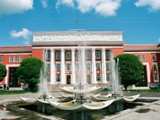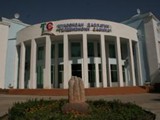| State symbols |
Photos of Money
SYMBOLS OF MONEY
The history of money circulation in the territory of Tajikistan dates back to antiquity.
The oldest coins found on the territory of Tajikistan were Achaemenid gold Dariko, (VI and V centuries. BC), represented in the famous Amu Darya treasure, discovered in 1878 in Kabadienskom area.
Ancient Bactria and Sogdiana, which included the territory of present-day Tajikistan, formed an important part of the Achaemenid Empire, and were incorporated into the orbit of the ancient international trade between East and West.
Monetary circulation in the territory of Tajikistan has been further developed by Alexander the Great and the Seleucids (IV - III c. mid-BC). It is noteworthy that under Antiochus I at the beginning of the III. BC functioned in Bactria Mint, which produced large silver coins (tetradrachms) with the name and portrait of the king.
The golden age of monetary circulation in the territory of Tajikistan belongs to the ancient Greco-Bactrian period (III-II centuries. BC).
When the Kushan circulation continued to grow and acquire new local features. The coins were struck in those days of gold, silver and copper. On the territory of Tajikistan, found an ancient treasure of more than 20 Kushan coins.
On Kushan coins dominated subjects related to religion zaroastriyskoy. At the same time the Kushan kings of moderately tolerant policy was carried out and placed on his coins the image of Indian god Shiva, and Buddha. They united together different peoples and cultures that have coexisted peacefully and successfully developed.
In the Middle Ages circulation reached its peak at the first dawn of the centralized state of Tajiks Samanids in the ninth and tenth centuries. When more than 30 cities in Transoxiana and Khorasan operated mints.
Samanid dirhams addressed not only within this state, but also far beyond.
Further growth of currency in Central Asia is related to the Timurid period (fifteenth century).. Large hoards of copper coins found in the Timurid. Dushanbe, Khujand, Hissar, Regar, and elsewhere.
The coinage continued in Central Asia until 1920
By the end of the reign of the last Emir of Bukhara Said Alimhan must first issuance of paper money in the territory of Central Asia, which were called "thongs" in the likeness of the existing silver coins.
Were put into circulation banknotes denomination of 20, 50, 100, 300, 500, 1000, 2000, 5000, 10000, tanga.
In September 1920 in the Emirate of Bukhara was formed People's Soviet Republic, which continued to produce the same bill with the emir's no major changes, including on the front of the banknotes in the upper circle of the words "Issued by order of His Majesty" was replaced by Soviet symbols - sickle and sheaf of wheat. There were also replaced with the name and the names of officers. All writing on this money have been executed in the Tajik language.
On the territory of modern Tajikistan banking institutions, as such until 1925 did not exist.
The need to open a separate banking institutions emerged with the formation of the Tajik Autonomous Soviet Socialist Republic (1924g.).
In May 1925, was announced later in Dushanbe Tajik national divisions of the State Bank.
The formation of the modern banking system was made possible after Tajikistan gained independence (September 9, 1991) and the establishment of the National Bank of Tajikistan.
Despite the fact that the Republic of Tajikistan gained independence in 1991, the territory of the republic until the end of 1993 was a period of currency in circulation of the Soviet Union and then from January 1, 1994 - Currency of the Russian Federation.
Tajikistan among the independent republics of the former Soviet Union remained the only country where, until May 1995. continued circulation of Russian rubles. This prompted a number of serious socio-economic problems: the steadily increasing domestic debt of the republic because of a lack of cash to pay salaries, pensions and benefits, financing of the economy has virtually stopped, and, finally, the National Bank of Tajikistan was unable to conduct its own independent monetary and monetary policies.
These and other problems dictate the need to enter your own currency.
Thus, in order to implement more effective economic policies, accelerating economic reforms and the creation of the monetary system of Tajikistan, on their own initiative and with the support of the President of Tajikistan Emomali respected Sharipovich Rakhmonov was decided to enter the national currency of Tajikistan.
Resolution of the State Commission of the Republic of Tajikistan for the introduction of the national currency on May 6, 1995, № 8 (324) "The order issued on the territory of the Republic of Tajikistan of the national currency - the Tajik ruble," with May 10, 1995 were put into circulation the national currency of Tajikistan - Rubles , in denominations of 1, 5, 10, 20, 50, 100, 200, 500, 1,000 rubles, in 1994 the sample emitted by the National Bank of Tajikistan.
The introduction of the national currency, held under auspices of the International Monetary Fund has been of great economic importance for the further development of the country and become a political, economic, social and cultural phenomenon.
Being in the treatment of more than 5 years, the currency has played a huge role in creating the foundations of the economic independence of the country and has prepared the necessary conditions for the launch of the new truly national currency.
The stabilization of the political and economic life of the National Bank of Tajikistan in 1999, placed an order for the company Giesecke & Divirent (Germany) for making the national currency, symbolizing the historical past and contemporary culture of the Tajik people.
Decree of the President of the Republic of Tajikistan on October 26, 2000 № 415, it was announced that the introduction of October 30, 2000 the new currency of the country - "TJS", named after the founder of the first centralized state of Tajiks Ismail Samani (849-907 gg.) Issued were issued banknotes in denominations of 1,5, 10, 20, 50, 100 Somoni bargaining unit and in denominations of 1, 5, 20, 50 dirams.
On the bills of the new currency portraits of prominent figures of our past and the Tajik people, as well as izobrazhenyya architectural and historical monuments of Tajikistan, works of applied art and life of the Tajik people.
In order to improve the structure of the monetary system of the Republic of Tajikistan by Presidential Decree № UP - 645 of August 28, 2001 September 3, 2001 were introduced metallic coins of 1, 3, 5 Somoni, and 5, 10, 20, 25, 50 dirams emitted by National Bank of Tajikistan. This latest coins were minted at the enterprises of the St. Petersburg Mint of the Russian Federation. It was found that the coin will have a parallel circulation of bank notes with the same dignity.
The national currency, which has a circulation in the area of ??sufficient authority, became the symbol of independent Tajikistan and is a reliable instrument for regulating the developing economy of our country. Today Somoni is one of the stable currencies in the CIS, which attracts the attention of financial interests of neighboring states.
In November 2004, first put into circulation commemorative coins of Tajikistan: 5 Somoni coins dedicated to the 10th anniversary of the Constitution of the Republic of Tajikistan and coins in 3 Somoni dedicated to the 80th anniversary of Tajikistan's capital Dushanbe. These coins were minted in two versions - silver and prefabricated material (brass and nickel silver). Coins made of prefabricated metal is in turnover of the country money.
On other language
- Photo
- Video
- Music
- Dushanbe
- Sogdian Area
- Khatlon Area
- Badakhshan
- Regions of Republican Subordination
- Guestbook
Areas of Tajikistan
link
Interview
Rate my site!
WEATHER
Exchange Rate











